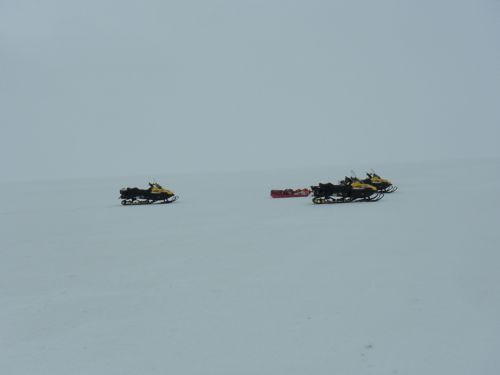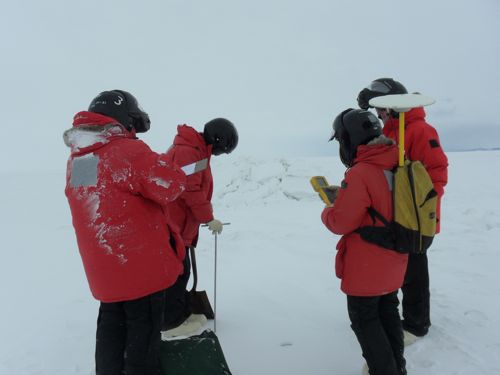Visit to Shackleton's Hut Cancelled
Sadly, our visit to Shackleton's hut on Cape Royds was cancelled today. We have been trying to get to Cape Royds to collect control samples for three days now, but the helicopters will not fly if the weather is bad. Luckily, we have plenty to do!
The McMurdo ice runway
Yesterday and today our research team has been zipping around on snow mobiles collecting snow samples from the McMurdo ice runway. The C-17 planes land on this runway early in the season when the sea ice is thick. However, as the temperatures rise, the sea ice becomes thinner until it is no longer safe for planes to land on it. The new runway is on thicker sea ice.

Why are we sampling snow?
Our team is sampling snow to look for evidence of air pollution at McMurdo. This is the first year our team is collecting snow samples, and although it is a lot of work, it is also fun!


We have random sampling locations programmed into our GPSA Global Positioning System (GPS) is a satellite-based navigation system used to track the location or position of objects on the Earth’s surface. for the snow samples, just like we did for the sediment samples. Joni uses the GPSA Global Positioning System (GPS) is a satellite-based navigation system used to track the location or position of objects on the Earth’s surface. to find the exact latitude and longitude of our sample. Unlike our sediment samples, these locations are much more spread apart. To make the sampling go faster, Joni (or Andrew) finds the locations while travelling on the back of a snowmobile!

Once we have found the correct location, we collect a sample of the snow at that site. Then we dig a hole and record the temperature and density of the snow using a snow density kit. The kit comes with a wedge-shaped container to collect snow, a scale to measure the mass of the snow, and thermometers. Lastly, we measure the grain size of the snow by flicking little flakes onto a scale that is photographed.

Shackleton's and Scott's science vs. our science
As I learn more about Shackleton's and Scott's adventures, it amazes me how much scientific research they accomplished in a harsh climate. Unlike us, they did not have GPSA Global Positioning System (GPS) is a satellite-based navigation system used to track the location or position of objects on the Earth’s surface. and snowmobiles to make their research easier.


During Scott's Antarctic expedition from 1901 to 1904, chief scientist, Edward Wilson and Ernest Shackleton would walk to the top of Crater Hill almost every day to read the temperature at the meteorological station. Wilson also spent time studying scurvy, which people on his expedition suffered and nearly died from. He also dissected his team's dead sled dogs to better understand their illnesses. These scientific endeavors were based on an immediate need for survival rather than an unhindered curiosity about the natural world. However, Shackleton's team also studied the magnetic South Pole and geology of Mt. Erebus and Scott's team studied the Emperor Penguins, among many other scientific explorations.
Questions
We are measuring the density of snow. What data do we need to collect to accurately calculate density? How would you collect data to find out what the density of snow is? (What steps would you take?)
If you were the first person to travel to Antarctica, what research or scientific explorations would you want to make and why?
Math Connections
If we spend 5 minutes collecting snow samples at each site and travelling to the next site, and we have 52 sites to go to, how long will we spend out in the field?
If the temperature of snow is at -5 degrees Celsius, how many more degrees does it need to rise to for it to melt?
Cool Careers in Antarctica

Meet Arthur Tarin. Arthur is currently on a South Pole Overland Traverse (SPOT) as the traverse medic. His job is to make sure the people in the SPOT team stay healthy despite the cold weather and high altitude. SPOT teams bring fuel and equipment to and from the South Pole by land. Arthur flew to the South Pole where he met the rest of the SPOT team, and will travel back to McMurdo with the remaining components of a field outpost. It will take him about two months to return from the South Pole because he is traveling at 8 miles per hour. It is 1,080 miles from McMurdo to Pole! He will travel for 10 - 12 hours a day, but luckily has two ipods full of books on tape to help him through the journey. This is Arthur's first season to Antarctica and he is excited about his trip. Arthur has lots of experience outdoors and has worked with an emergency rescue team in the wilderness. You can learn more about his adventure at artsadventures.shutterfly.com

Comments